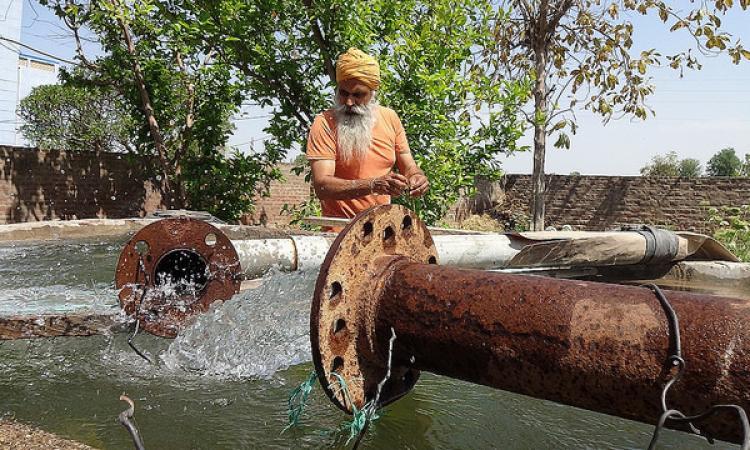
Punjab, sucked dry
A number of aggressive and unsustainable agricultural practices have been found to lead to severe groundwater depletion in India. For example, the Indo-Gangetic plains in northwest India are undergoing severe groundwater depletion due to excessive and inefficient use of water in agriculture. And no where is this more evident than in the state of Punjab, the food bowl of India!
The paper titled 'Can crop diversification be widely adopted to solve the water crisis in Punjab?" published in Current Science informs that groundwater depletion has reached alarming levels in Punjab, a pioneer of green revolution in India. While Punjab continued to grow a diverse variety of crops before the green revolution, this was rapidly replaced by paddy–wheat cultivation post the green revolution.
The area under paddy in the state has increased rapidly, from 0.39 million ha in 1970–1971 to 3.1 million ha in 2018–2019 thus leading to dangerous levels of groundwater exploitation due to water guzzling paddy and inefficient irrigation practices.
The situation has turned so precarious that aquifers in about 79 percent of the total area of Punjab are now overexploited. Of the total 138 development blocks the state, groundwater has been found to be overexploited in 109 blocks, critical in 2 blocks and semi-critical in 5 blocks. The average depth of the water table has decreased from 7.32 m in 1998 to 12.79 m in 2012 with a depletion rate of 0.37 m/yr.
This trend will not only adversely affect agricultural productivity in the state, but also threaten the food security of India as Punjab’s agriculture has the largest contribution to India’s food stock.
Crop diversification, the way out?
Crop diversification, that aims at replacing water guzzling paddy- cultivated on over 85 percent of the cropped land with less water-intensive crops, is being proposed as a strategy to overcome the groundwater crisis in Punjab.
Crop diversification can lead to several benefits like conservation of groundwater, revitalisation of soil leading to improved productivity and efficient use of resources, strengthening of the rural sector by increasing employment opportunities and ecological gains through sustainable agricultural practices. However, many farmers in Punjab are reluctant to adopt it.
Challenges to adoption of crop diversification in Punjab
Experts argue that this has to do with the agricultural policies adopted by both the State and Central Governments in Punjab. For example, the current policies on minimum support price (MSP) and assured procurement, free electricity, easy and subsidised purchase of submersible pumps and fertilisers serve to encourage wheat and paddy cropping while alternative crops lack price and procurement support.
Public procurement of crops other than wheat and paddy is non existent in the state while other crops continue to suffer at the hands of private companies due to lack of effective implementation of MSP. Thus, farmers do not consider the adoption of alternative crops as profitable and many continue to be unaware of the existence of MSP for alternative crops in the policy.
Infrastructural insufficiencies and inadequate public and private investments in agricultural infrastructure hinder crop diversification. This is because almost all the marketed surplus of paddy and wheat is procured by the Government and thus farmers have no need to arrange for storage facilities.
On the contrary, alternative crops, especially fruits and vegetables, require large cold storage facilities. Farmers see no profit in growing alternative crops and making effort to have storage facilities for alternative crops under these circumstances.
Lack of capital investment for machinery and paraphernalia for alternative crops is also one of the constraints that farmers face. Agricultural processing, in both organised and unorganised sectors, also plays a very limited role in Punjab’s agricultural production and restricts the development of value-adding industries in the state.
Also, alternative crops do not have the demand and easy marketability that wheat and paddy have in the state and in the country and markets for such crops are often riddled with imperfections.
However, experts suggest that adoption of crop diversification among a large number of farmers who have landholdings of more than 2 ha in the state, can greatly help in encouraging water saving practices and prevent groundwater depletion.
What can be done to change the situation?
- Designing crop plans that encourage cropping patterns that maximise net returns and save groundwater while ensuring remunerative prices or MSP, and effective public and private procurement on the prices that would encourage farmers to shift to new crops.
- Involving Gram Panchayats, NGOs and cooperative societies to help the government in implementing and planning for patterns of regional cropping.
- Passing on savings generated from less use of water and electricity through adoption of alternative crops to farmers to incentivise farmers to continue with the practice while subsidising inputs, aiding easy or cheaper credit availability for diversification along with subsidised crop insurance.
- Conducting training and awareness campaigns on technical and financial aspects of crop diversification among farmers.
- Identification and strengthening of supply and value chains to create markets for crops, and delivering profitability to farmers. For this, setting up of processing and other supplementary
- industries in rural areas would generate value for the agricultural sector, and also boost rural non-farm employment.
- Horizontal diversification backed by state or regional-level crop planning, and vertical diversification – in the form of rural industrialisation to change deep rooted agricultural practices
Effective policies that would ensure fixing of commercially remunerative MSP for alternative crops; creating marketing infrastructure; strengthening market information and intelligence; increasing public and private investment in rural infrastructure; research and extension services and provision of credit assurance and risk insurance for alternative crops can go a long way in changing the current situation in Punjab, argues the paper.
/articles/crop-diversification-address-water-crisis-punjab